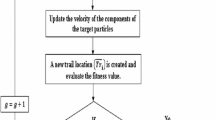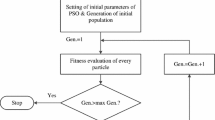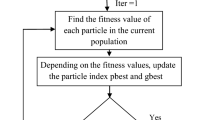Abstract
This paper presents a novel hybrid model reduction method to simplify large-scale continuous-time single-input–single-output and multi-input–multi-output dynamic systems using the advantages of the balanced truncation method and the particle swarm optimization (PSO) algorithm. The balanced truncation method obtains the reduced model denominator coefficients to ensure stability. The PSO algorithm minimizes the integral square error between the step responses of the original system and the reduced model as much as possible. It leads to the optimal numerator coefficients. The advantage of the proposed approach is that, for optimizing reduced model numerator coefficients, the search space boundaries of the PSO algorithm are not entirely random. They are selected using the balanced truncated reduced model numerator. So, the suggested method avoids two significant problems with evolutionary algorithms: the arbitrary choice of search space and the longer simulation time. Four power system models and four numerical examples from the literature are considered to assess the effectiveness of the proposed reduction method. The step responses and Bode diagrams for the higher-order system and its corresponding reduced models are displayed. For comparison, statistics are tabulated based on the rise time, the settling time, the peak overshoot, the integral square error, and the root-mean-square error. The proposed method ensures stability and other features of the higher-order system in the reduced model. The performance measure values and the time domain characteristics demonstrate the ability and effectiveness of the proposed approach. All the case studies use a MATLAB simulation environment.
















Similar content being viewed by others
Data Availability
For case studies involving a hydro-power system, a single area reheated hydro-thermal power system, and the SMIB power system, the corresponding author, is willing to provide block diagrams, basic mathematical descriptions, and operating points upon reasonable request.
References
D.I. Abu-Al-Nadi, M.K.O. Alsmadi, Z.S. Abo-Hammour, Md.F. Hawa, J.S. Rahhal, Invasive weed optimization for model order reduction of linear MIMO systems. Appl. Math. Model. 37(6), 4570–4577 (2013). https://doi.org/10.1016/j.apm.2012.09.006
L.A. Aguirre, Quantitative measure of modal dominance for continuous systems, in Proceedings of the 23rd Conference on Decision and Control (1993), pp. 2405–2410. https://doi.org/10.1109/CDC.1993.325629
N. Ahamad, A. Sikander, A novel approach of order diminution using time moment concept with Routh array and Salp swarm algorithm. Turk. J. Electr. Eng. Comput. Sci. 29(2), 1077–1091 (2021). https://doi.org/10.3906/elk-2005-120
N. Ahamad, A. Sikander, G. Singh, A novel reduction approach for linear system approximation. Circuits Syst. Signal Process. 41, 700–724 (2022). https://doi.org/10.1007/s00034-021-01816-4
I. Al-Iedani, Z. Gajic, Order reduction of a wind turbine energy system via the methods of system balancing and singular perturbations. Electr. Power Energy Syst. (2020). https://doi.org/10.1016/j.ijepes.2019.105642
O. Alsmadi, A. Al-Smadi, E. Gharaibeh, Firefly artificial intelligence technique for model order reduction with substructure preservation. Trans. Inst. Meas. Control. 41(10), 2875–2885 (2019). https://doi.org/10.1177/0142331218814288
O. Alsmadi, A. Al-Smadi, M. Ma’aitah, Model order reduction with true dominant poles preservation via particle swarm optimization. Circuits Syst. Signal Process. 39, 5501–5513 (2020). https://doi.org/10.1007/s00034-020-01443-5
A.C. Antoulas, Approximation of Large-Scale Dynamical Systems (SIAM, Philadelphia, 2005)
S. Arun, T. Manigandan, P. Mariaraja, Pole clustering-based modified reduced-order model for boiler system. IETE. J. Res. (2020). https://doi.org/10.1080/03772063.2020.1754300
S. Biradar, Y.V. Hote, S. Saxena, Reduced-order modeling of linear time-invariant systems using big bang big crunch optimization and time moment matching method. Appl. Math. Model. 40(15–16), 7225–7244 (2016). https://doi.org/10.1016/j.apm.2016.03.006
S.L. Cheng, C. Hwang, Optimal approximation of linear systems by a differential evolution algorithm. IEEE Trans. Syst. Man. Cybernet. Part A Syst. Hum. 31(6), 698–707 (2001). https://doi.org/10.1109/3468.983425
O.K. Erol, I. Eksin, A new optimization method: big bang-big crunch. Adv. Eng. Softw. 37(2), 106–111 (2006). https://doi.org/10.1016/j.advengsoft.2005.04.005
L. Fortuna, G. Nunnari, A. Gallo, Model Order Reduction Techniques with Applications in Electrical Engineering (Springer, Berlin, 1992)
Z. Gallehdari, M. Karrari, O.P. Malik, Model order reduction using PSO algorithm and its application to power systems, in 2009 International Conference on Electric Power and Energy Conversion Systems (EPECS) (IEEE, 2009)
D.E. Goldberg, Genetic Algorithms in Search, Optimization and Machine Learning, 1st edn. (Addison-Wesley Longman Publishing CO., Inc., Boston, 1989)
Y. Gu, N. Bottrell, T.C. Green, Reduced-order models for representing converters in power system studies. IEEE Trans. Power Electron. 33(4), 3644–3654 (2018). https://doi.org/10.1109/TPEL.2017.2711267
S. Jain, Y.V. Hote, Order diminution of LTI systems using modified big bang big crunch algorithm and Pade approximation with fractional order controller design. Int. J. Control Autom. Syst. 19(6), 2105–2121 (2021). https://doi.org/10.1007/s12555-019-0190-6
M. Juneja, S.K. Nagar, S.R. Mohanty, PSO Based reduced order modelling of autonomous AC microgrid considering state perturbation. J. Control Meas. Electron. Comput. Commun. 61(1), 66–78 (2020). https://doi.org/10.1080/00051144.2019.1682867
J. Kennedy, R. Eberhart, Particle swarm optimization, in Proceedings of IEEE International Conference on Neural Network (1995), pp. 1942–1948. https://doi.org/10.1109/ICNN.1995.488968
J. Ma, Z. Song, Y. Zhang, Y. Shen, J.S. Thorp, Model order reduction analysis of DFIG integration on the power system small-signal stability considering the virtual inertia control. IET Gener. Transm. Distrib. 11(16), 4087–4095 (2017). https://doi.org/10.1049/iet-gtd.2017.0518
E. Malekshahi, S.M.A. Mohammadi, The model order reduction using LS, RLS and MV estimation methods. Int. J. Control. Autom. Syst. 12, 572–581 (2014). https://doi.org/10.1007/s12555-013-0250-2
B.C. Moore, Principal component analysis in linear systems: controllability, observability and model reduction. IEEE Trans. Autom. Control AC 26, 17–32 (1981). https://doi.org/10.1109/TAC.1981.1102568
A. Mouhou, A. Badri, Low integer-order approximation of fractional-order systems using grey wolf optimizer-based cuckoo search algorithm. Circuits Syst. Signal Process. 41, 1869–1894 (2022). https://doi.org/10.1007/s00034-021-01872-w
A. Narwal, R. Prasad, Order reduction of LTI systems and their qualitative comparison. IETE Tech. Rev. 34(5), 655–663 (2017). https://doi.org/10.1080/02564602.2016.1237859
D.P. Papadopoulos, A.K. Boglou, Reduced-order modelling of linear MIMO systems with the Padé approximation method. Int. J. Syst. Sci. 21(4), 693–710 (1990). https://doi.org/10.1080/00207729008910402
B. Parang, M. Mohammadi, M.M. Arefi, Residualisation-based model order reduction in power networks with penetration of photovoltaic resources. IET Gener. Transm. Distrib. 13(13), 2619–2626 (2019). https://doi.org/10.1049/iet-gtd.2018.6172
S.R. Potturu, R. Prasad, R. Meshram, Improved simplification technique for LTI systems using modified time moment matching method. Sadhana 46(3), 1–11 (2021). https://doi.org/10.1007/s12046-021-01647-8
A.K. Prajapati, R. Prasad, Order reduction in linear dynamical systems by using improved balanced realization technique. Circuits Syst. Signal Process. 38, 5289–5303 (2019). https://doi.org/10.1007/s00034-019-01109-x
A.K. Prajapati, R. Prasad, Reduction of linear dynamic systems using the generalized approach of the pole clustering method. Trans. Inst. Meas. Control (2021). https://doi.org/10.1177/01423312211063307
A.K. Prajapati, R. Prasad, Reduced order modelling of linear time-invariant systems using factor division method to allow retention of dominant modes. IETE Tech. Rev. 36(5), 449–462 (2019). https://doi.org/10.1080/02564602.2018.1503567
A.K. Prajapati, R. Prasad, Reduced order modelling of LTI systems by using Routh approximation and factor division method. Circuits Syst. Signal Process. 38, 3340–3355 (2019). https://doi.org/10.1007/s00034-018-1010-6
A.K. Prajapati, R. Prasad, A new generalized pole clustering-based model reduction technique and its application for design of controllers. Circuits Syst. Signal Process. 41, 1497–1529 (2022). https://doi.org/10.1007/s00034-021-01860-0
A. Ramirez, A. Mehrizi-Sani, D. Hussein, M. Matar, M. Abdel-Rahman, J. Jesus Chavez, A. Davoudi, S. Kamalasadan, Application of balanced realizations for model-order reduction of dynamic power system equivalents. IEEE Trans. Power Deliv. 31(5), 2304–2312 (2016). https://doi.org/10.1109/TPWRD.2015.2496498
R. Salim, M. Bettayeb, H2 and H∞ optimal model reduction using genetic algorithms. J. Frankl. Inst. 348, 1177–1191 (2011). https://doi.org/10.1016/j.jfranklin.2009.10.016
A. Sikander, R. Prasad, Soft computing approach for model order reduction of linear time-invariant systems. Circuits Syst. Signal Process. 34, 3471–3487 (2015). https://doi.org/10.1007/s00034-015-0018-4
A. Sikander, R. Prasad, A novel order reduction method using cuckoo search algorithm. IETE. J. Res. 61(2), 83–90 (2015). https://doi.org/10.1080/03772063.2015.1009396
A. Sikander, R. Prasad, A new technique for reduced order modelling of the linear time-invariant system. IETE. J. Res. 63, 316–324 (2017). https://doi.org/10.1080/03772063.2016.1272436
A. Sikander, R. Prasad, Linear time-invariant system reduction using mixed method approach. Appl. Math. Model. 39(16), 4848–4858 (2015). https://doi.org/10.1016/j.apm.2015.04.014
J. Singh, C. Kalyan, C.B. Vishwakarma, Two degrees of freedom internal model control-PID design for LFC of power systems via logarithmic approximations. ISA Trans. 72, 185–196 (2018). https://doi.org/10.1016/j.isatra.2017.12.002
J. Singh, C.B. Vishwakarma, C. Kalyan, Biased reduction method by combining improved modified pole clustering and improved Pade approximations. Appl. Math. Model. 40, 1418–1426 (2016). https://doi.org/10.1016/j.apm.2015.07.014
N.K. Sinha, B. Bandopadhyay, Model reduction with balanced realization: a new interpretation, in European Control Conference (1999), pp. 3575–3580. https://doi.org/10.23919/ECC.1999.7099885
H.N. Soloklo, M.M. Farsangi, Multi-objective weighted sum approach model reduction by Routh-Pade approximation using harmony search algorithm. Turk. J. Electr. Eng. Comput. Sci. 21(2), 2283–2293 (2013). https://doi.org/10.3906/elk-1112-31
R. Stanisławski, M. Rydel, K.J. Latawiec, New implementation of discrete-time fractional-order PI controller by use of model order reduction methods, in Advanced, Contemporary Control. Advances in Intelligent Systems and Computing, vol. 1196 (Springer, Cham). https://doi.org/10.1007/978-3-030-50936-1_100
G. Vasu, M. Sivakumar, M. Ramalingaraju, A novel model reduction approach for linear time-invariant systems via enhanced PSO-DV algorithm and improved MPPA method. Proc. Inst. Mech. Eng. Part I J. Syst. Control Eng. 234(2), 240–256 (2020). https://doi.org/10.1177/0959651819849372
G. Vasu, M. Sivakumar, M. Ramalingaraju, Optimal model approximation of linear time invariant systems using the enhanced DE algorithm and improved MPPA Method. Circuits Syst. Signal Process. 39, 2376–2411 (2020). https://doi.org/10.1007/s00034-019-01259-y
P. Vorobev, P.H. Huang, M. Al Hosani, J.L. Kirtley, K. Turitsyn, High-fidelity model order reduction for microgrids stability assessment. IEEE Trans. Power Syst. 33(1), 874–887 (2017). https://doi.org/10.1109/TPWRS.2017.2707400
U.K. Yadav, V.P. Singh, R-method-based reduction of continuous systems using Grey Wolf optimization algorithm. Circuits Syst. Signal Process. (2022). https://doi.org/10.1007/s00034-022-02144-x
X.S. Yang, S. Deb, Engineering optimization by cuckoo search. Int. J. Math. Model. and Numerical Optimization. 1(4), 330–343 (2010) https://doi.org/10.48550/arXiv.1005.2908
R. Zerrougui, A.B.H. Adamou-Mitiche, L. Mitiche, A novel machine learning algorithm for interval systems approximation based on artificial neural network. J. Intell. Manuf. (2022). https://doi.org/10.1007/s10845-021-01874-0
A. Zhao, J.-Q. Sun, Control for stability improvement of high-speed train bogie with a balanced truncation reduced order model. Int. J. Veh. Mech. Mobil. 60(12), 4343–4363 (2022). https://doi.org/10.1080/00423114.2021.2025408
Author information
Authors and Affiliations
Corresponding author
Ethics declarations
Conflict of interest
The authors declare that they have no conflict of interest.
Additional information
Publisher's Note
Springer Nature remains neutral with regard to jurisdictional claims in published maps and institutional affiliations.
Appendix
Appendix
Parameters used for the PSO algorithm:
The choice of PSO parameters has a significant impact on optimization performance. Considered the following assumptions while simulating the PSO algorithm:
No. | Parameters | values | Remarks |
|---|---|---|---|
1 | Swarm or population size (N) | 100 | The swarm's initial variety increases according to the number of particles in it. The search space can be covered in a larger area every iteration when there is an immense swarm. However, the search degrades to a similar random search as the number of particles increases and the computing cost of each iteration increases. In addition, more enormous swarms may require fewer iterations to arrive at a workable solution than smaller ones |
2 | Maximum number of Iterations (Tmax) | 100 | A small number of iterations may result in premature convergence. An excessive number of iterations results in unnecessarily increased computing complexity (provided that the number of iterations is the only stopping condition). It is particular to a given issue |
3 | Inertia weight (w) | 1 | The inertia weight regulates the influence of the initial velocity in a new direction. Exploration (which diverts the swarm's global search) is caused by a significant inertia weight, whereas a lower inertia weight causes exploitation (decelerates the particles). So, the balance between the exploration and exploitation phases is good when the inertia weight changes from iteration to iteration instead of staying the same. In each iteration, the “w” will be multiplied by a user-defined damping ratio and get smaller as the algorithm advances |
Inertia weight damping ratio (wdamp) | 0.9 | ||
4 | Cognitive part acceleration coefficient (ccc) | 2 | The practical and precise search for the optimal global solution depends heavily on the appropriate regulation of the two acceleration factors. If ccc >> csp, each particle is considerably more drawn to its own personal best position, resulting in extreme wandering. On the other hand, if csp >> ccc, particles are more intensely enticed to the global best place, driving particles to pour prematurely towards optima. If ccc = csp, particles are allured towards the average of local best position Pbest, i, and global best |
5 | Social part acceleration coefficient (csp) | 2 | |
6 | Solution/search space bounds | Select the bounds according to the criteria discussed in this article | |
7 | Steady-state gain approximation | The steady-state value of the higher-order system is preserved closely in the simplified model, so the steady-state error is nearly zero | |
Rights and permissions
Springer Nature or its licensor (e.g. a society or other partner) holds exclusive rights to this article under a publishing agreement with the author(s) or other rightsholder(s); author self-archiving of the accepted manuscript version of this article is solely governed by the terms of such publishing agreement and applicable law.
About this article
Cite this article
Duddeti, B.B., Naskar, A.K. & Subhashini, K.R. Order Reduction of LTI Systems Using Balanced Truncation and Particle Swarm Optimization Algorithm. Circuits Syst Signal Process 42, 4506–4552 (2023). https://doi.org/10.1007/s00034-023-02304-7
Received:
Revised:
Accepted:
Published:
Issue Date:
DOI: https://doi.org/10.1007/s00034-023-02304-7




